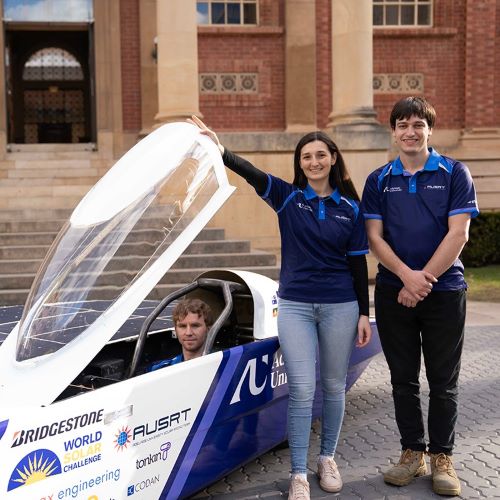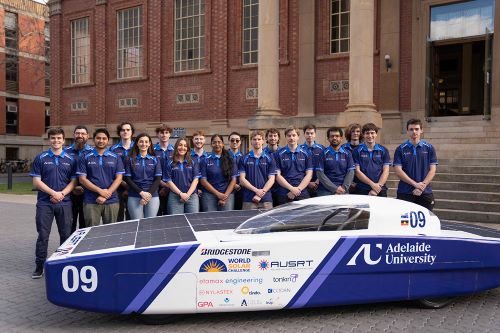11 August 2025

Using a fully solar-powered vehicle built from scratch, university students will race across Australia as part of the world’s biggest solar car challenge aimed to foster sustainable transport innovation.
The biannual event, Bridgestone World Solar Challenge, sees students from around the world design and manufacture a vehicle powered solely by the sun, to be driven from Darwin to Adelaide CBD via Stuart Highway — a 3020km journey mixing with traffic on public roads.
This year’s competition will run from August 24 to 31, with 37 teams competing, largely made up of university students from engineering, maths, science, business, and media disciplines.
Students from the University of Adelaide have competed as Adelaide University Solar Racing Team (AUSRT) since 2015; this year, for the first time, UniSA students have come on board expanding the team across both institutions ahead of their unification as Adelaide University from 2026.
Together, the team has designed and built Lumen III which is the first new car for AUSRT in eight years and the most advanced vehicle AUSRT has ever created.
AUSRT Team Manager and final-year Electrical and Electronic Engineering student Adam Palkovics says it’s been a challenging but rewarding ride, with construction progressing well.
“The team is feeling very excited about the 2025 Bridgestone World Solar Challenge, especially since it’s our first time building a car from scratch,” Palkovics says.
“The challenge itself is gruelling and extremely difficult to complete. In general, only ten out of 30 to 40 teams make it to the finish line. Our main goal is to finish the challenge for the first time for AUSRT.”
The energy-efficient electric vehicle Lumen III has been in development since the end of the last race in 2023, with the majority of the current team joining in 2024. While the race has regulations such as car dimensions, battery size and solar array limits, it’s ultimately a design-led competition encouraging creativity.
AUSRT’s design philosophy is centred around safety and reliability, with a strong focus on performance and balancing weight with aerodynamics.
“We’ve learned to do more with less, especially in ‘David versus Goliath’ situations. Our past success has come from building a car that doesn’t break down, and we’ve used those lessons to optimise our new design,” Palkovics says.
“The race is more like a marathon than a sprint. We’ll be adjusting our strategy every ten minutes to calculate the most energy-efficient speed to cruise at.”
AUSRT race strategist and UniSA PhD candidate in mathematics Maria Kapsis is responsible for devising that strategy and ensuring the team’s vehicle is operating as efficiently as possible on the journey from Darwin to Adelaide.

“One of my main jobs is to optimise Lumen III’s solar array so that it provides maximal performance in gathering energy from the harsh Australian sun,” Kapsis says.
“I’ve also been working with a group of third-year mathematics students to develop software that will provide the team with the most efficient cruising speeds during the race.”
UniSA mathematics student Rong Xu has helped Kapsis as part of her final-year project and says developing the software has involved multiple steps.
“Using data from previous races, we’ve developed a mathematical model to calculate how much solar energy the vehicle will need for the race then, using solar radiation forecasts, calculated how much solar energy would be available to the vehicle during the race,” Xu explains.
“We’ve created a simulation of the vehicle’s journey from Darwin to Adelaide to determine the best speed profile for the car, while testing it under different weather scenarios to demonstrate how driving strategies should adapt to changing conditions.”
The competition aligns with the students’ values for sustainability while developing their problem-solving abilities.
“For the AUSRT team, renewable energy and solar racing isn’t just a hobby, it’s a passion. We’re all really driven to innovate and get involved in the sustainable energy sector,” Palkovics says.
“Being part of the solar racing team lets us apply the theory we learn in class to real-world challenges.”
The competition generates key industry partnerships for universities, and often leads to job opportunities with global leaders in engineering, automotive, and sustainable transport.
“It gives students an opportunity to develop skills that are sought after by industry,” Kapsis says.
As a part of an ongoing partnership, Adelaide University is providing logistic support to the aCentauri Solar Racing team from ETH Zurich university. This enables students and academics from both institutions to build relationships that will strengthen research on solar powered cars well into the future.
“There’s huge reward in competing in the Bridgestone World Solar Challenge, not just in the experience, but in knowing we’re building one of the fastest solar cars in the world,” Palkovics says.
“It’s not often you get the opportunity to compete at an international level while also creating the experience of a lifetime.”
The Bridgestone World Solar Challenge will be livestreamed on YouTube. Keep up to date with Adelaide University Solar Racing Team on Facebook and find out more on the Bridgestone World Solar Challenge website.
Media contact:
Lara Pacillo, Media Officer, The University of Adelaide. Mobile: +61 404 307 302. Email: lara.pacillo@adelaide.edu.au



